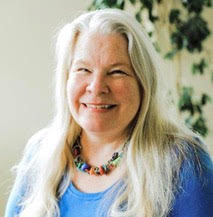The soft light seeping around the edges of the blinds gave me the mistaken impression that the sun was rising. I arose from my bed and headed toward the living room to begin my day by journaling. Stepping into the dark hallway, I noticed a square of light on the floor. Moonlight, not sunlight, was streaming through the windows. The wolf moon, the first full moon of 2023, was putting on a spectacular display in the predawn hour.
In the home where I lived for 30 years before relocating last fall, I knew which windows to look out to see the full moon at its rising and setting. In my new locale, I had learned where to position myself in the evening to spot the moon emerging over the ridge, but this was the first time I had witnessed the full moon setting over the mountain across the valley. As I breathed in the beauty of this sacred moment, I remembered a holy day was dawning: A full moon is as good as a star on Epiphany.

Tambi Brown Swiney
Awash in lunar peacefulness, I watched as the moon slowly descended through the western sky toward the mountain top. The uppermost branches of the trees on the summit were briefly illuminated by the leading edge of light. Then the shimmering silhouette of the entire ridgeline was visible before the moon vanished completely. In a few moments, the mountain would be bathed in the warm, orange glow of the rising sun. I breathed deeply, grateful for my early morning epiphany — the glory of God once again had been revealed.
I was in my fourth decade of life before I learned about the Feast of the Epiphany. During my first year of seminary, a classmate invited me to attend her ordination service. Since this would be my first opportunity to witness a woman being ordained, I was eager to make the required road trip. When I inquired about the date of the service, my friend replied brightly: “Epiphany!” I was embarrassed to admit I required additional information.
“I was in my fourth decade of life before I learned about the Feast of the Epiphany.”
None of the Baptist churches where I worshipped as a child, teenager, college student or young adult observed the liturgical seasons. Any reference to the church calendar was tied either to the budget year or the committee year, not the Christian year. Christmas and Easter were our only high holy days. Epiphany never was mentioned. Lent was deemed to be too Catholic. Perhaps Pentecost was excessively inclusive? Ordinary time was too ordinary. Advent was a bit of a downer: No one wanted to wait to sing joyful Christmas carols until Jesus’ birthday.
I am grateful the congregation that called me to serve as associate pastor followed the liturgical year. My experience of worship was enriched as we journeyed in tandem with Christians around the world. I was responsible for planning activities for the congregation that further illuminated each liturgical season. Guiding children and youth to explore the colors and symbols and stories associated with these holy seasons was a joyful endeavor. A gifted church member created a lovely series of child-sized banners to mark the seasons; we displayed them in “The Shepherd’s Corner” — the children’s prayer room.
This year, I had my first opportunity to explore Epiphany with my 2-year-old grandson. Energized by my early morning lunar encounter, I mentally sketched out my teaching plan. After quickly perusing my bookshelves, I realized to my dismay I only owned one book specifically focused on Epiphany — a pocket-sized paperback titled The Three Wise Men, a gift I received on my second birthday. (I know this fact because my mother carefully penned my name and the date on the inside cover.) I plucked the paperback from the shelf and headed out.
As I drove, I considered the other storytelling resources available to me at my grandson’s house: the felt nativity set I had given him prior to Christmas; the wooden blocks overlaid with images from the birth narratives, lovingly created by his maternal grandparents; the cloth Advent calendar my mother had given my son during his toddlerhood.
“I reminded myself that the odds were slim that I would be able to hold my grandson’s attention long enough to tell the whole story, much less offer insightful commentary.”
Suddenly, my theologically enlightened mind kicked in, prompting a wave of questions. Should I explain to my grandson that we don’t really know how many wise men visited Jesus? Matthew mentions three gifts, but that does not mean there were three givers. Do I point out that Jesus probably wasn’t still sleeping in a manger when the gift-bearers arrived? Jesus might have been the same age as my grandson when these strangers knocked on the door. Do I need to make it clear that these wise men were not kings? Most of the nativity sets at my house feature a trio of crown-clad men visiting a baby in a manger. Then I reminded myself that the odds were slim that I would be able to hold my grandson’s attention long enough to tell the whole story, much less offer insightful commentary.
Throughout the day, I took advantage of teachable moments. Did you know today is a special day? Today is Epiphany! Can you say “Epiphany”? While he snacked, I offered to read aloud the special book I had brought from home. I was grateful for his inattentiveness when I realized the text was woefully inappropriate on multiple levels. I hid the book.
Later, I orchestrated encounters with the felt wise men, the wooden wise men and the cloth wise men. By the time I left the house to attend an evening Epiphany service at church, those nine wise men were scattered throughout the living room. Although my grandson had not paid much attention to the ones who traversed afar two millennia ago, my interest had been piqued. I wondered if the magi had interrupted Jesus’ naptime with their unplanned visit. I wondered if Jesus had shyly hidden behind his mother when they introduced themselves. I wondered if Jesus had asked if they had any other surprises for him after they presented their gifts of gold, frankincense and myrrh.
I was excited about the Epiphany service because I was eager to receive my star word — a spiritual practice I have grown to cherish in recent years. I was intrigued when I discovered my star word for 2023 is “curiosity.” In a conversation with my spiritual director earlier in the day, she asked me how I was feeling as I settled into a new season of life after moving away from my home state. “Curious,” I replied. Clearly, the Spirit of God was at work.
Curiosity. That’s what prompted the Magi to study the stars in the first place. When they observed that stunning star, they asked questions and sought to discover its significance. Curiosity precipitated their journey to seek out the Christ Child. Their work led to worship. These unnamed, unnumbered Gentile wise men interpreted a stellar phenomenon as a divine invitation; thus, curiosity led to a divine encounter with God incarnate.
Curiosity. Perhaps my grandson can be my guide this year as I explore my star word. Possessing the innate curiosity of a preschooler, he is a keen observer of the people, places and things comprising his world. As he listens and learns, curious questions naturally spring forth. Why did Tam Tam’s car have a flat tire? Why is the Children’s Museum closed at night? Why does my body need rest?
Curiosity. My grandson already is curious about the moon. While I have long been drawn to the ineffable beauty of the full moon, he is captivated by the mystery of the new moon. When asked, he can readily explain why there are times when the moon isn’t visible to us: “The sun is lighting up the other side of the moon.” I wonder if that scientific reality will eventually bolster his faith in the same way it does mine. Just as the moon continues to chart its elliptical course around the earth even though darkness seems to have extinguished its light, the Spirit of God continues to move in my life and in the world in the darkest of times.
The moon will be a waning crescent when the Feast of the Epiphany dawns next year. My grandson undoubtedly will have new questions about the old story of the wise men’s visit to Jesus; I will, too. In the meantime, I intend to follow the magi’s example by engaging my sacred curiosity — searching the skies, pondering beauty and responding to the Spirit’s prompting to seek out the divine.
Tambi Brown Swiney is a writer who draws inspiration from the moon, the mountains and her 2-year-old grandson.
Related articles:
On Epiphany, let us resolve to go on | Opinion by Paul Baxley

